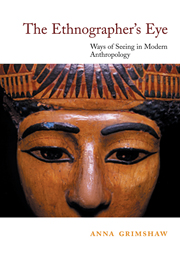Epilogue
Published online by Cambridge University Press: 05 June 2012
Summary
The Ethnographer's Eye is conceived as a manifesto. It seeks to establish a new agenda for visual anthropology. My interest is not in arguing for its legitimacy as a subdiscipline with its own specialist interests and methods; rather I suggest that vision is central to modern anthropology whether explicitly foregrounded or not. For an exploration of anthropology's ways of seeing opens up the questions concerning knowledge, technique and form at the heart of the anthropological project itself.
In arguing for the dissolution of boundaries around the subdiscipline, I follow other commentators such as Faye Ginsburg and David MacDougall in proposing the reintegration of a visual perspective into ethnographic work. But, as both MacDougall and Lucien Taylor have noted, the pursuit of such a strategy is made difficult by the suspicion and defensiveness which exists on both sides of the divide. On the one hand, anthropologists committed to language and writing have long sought to establish anthropology as the pursuit of a particular kind of knowledge built upon the marginalisation, containment and sometimes downright suppression of the visual. On the other hand, many ‘visual’ anthropologists have sought legitimation by turning away from an engagement with the mainstream textual tradition at the same time as transposing its concerns by means of the attempt to ‘linguify’ film. This curious paradox is, of course, hopelessly self-limiting. MacDougall suggests that ‘visual anthropology may need to define itself not at all in terms of written anthropology but as an alternative to it, as a quite different way of knowing related phenomena’.
- Type
- Chapter
- Information
- The Ethnographer's EyeWays of Seeing in Anthropology, pp. 172 - 173Publisher: Cambridge University PressPrint publication year: 2001

